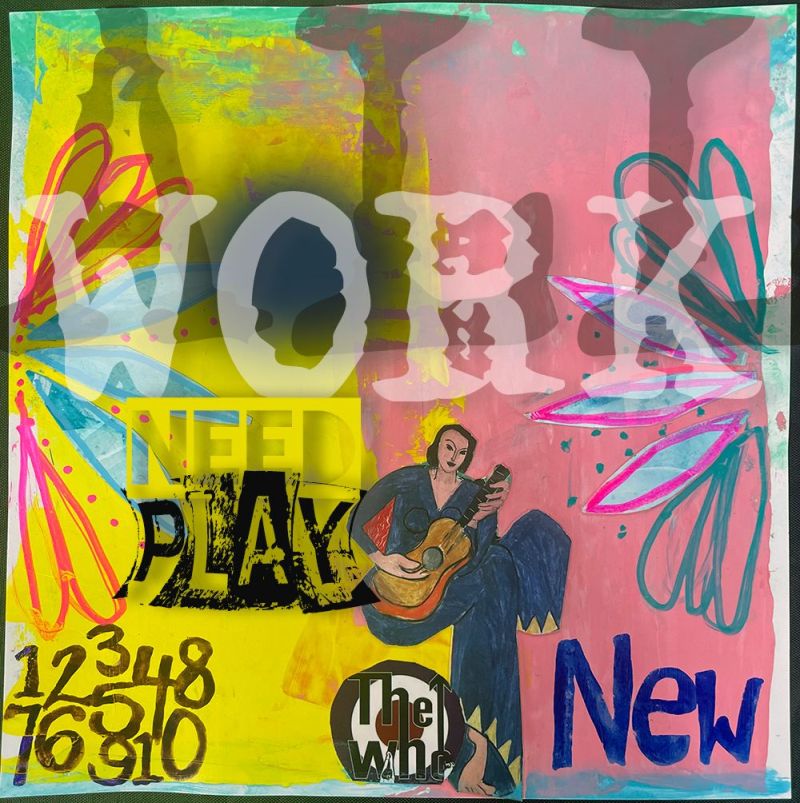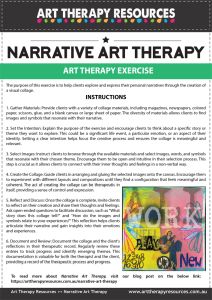THIS POST INCLUDES:
1. Introduction to Narrative Art Therapy
2. Techniques and Exercises
3. Developing an Art Therapy Exercise
4. Free Download Journaling Prompts for Mental Health
INTRODUCTION TO NARRATIVE ART THERAPY
Narrative art therapy represents a unique blend of narrative therapy and art therapy, focusing on the power of storytelling through visual means.
Narrative art therapy is grounded in the belief that storytelling through art can facilitate psychological insights and emotional healing. Rooted in the theoretical frameworks of narrative therapy, pioneered by Michael White and David Epston, this modality emphasizes the importance of personal narratives in shaping our identities and experiences. Narrative art therapy extends this concept by incorporating artistic expression, enabling clients to externalize and reframe their stories in a tangible, visual form.
Narrative therapy posits that individuals construct their identities through the stories they tell about their lives. By re-authoring these stories, individuals can gain new perspectives and develop healthier self-concepts. Narrative art therapy builds on this foundation by integrating art-making processes, allowing clients to visualize and reconstruct their narratives creatively.
Storytelling, as a therapeutic tool, holds significant potential in fostering emotional understanding and psychological healing. Personal narratives, when articulated through art, provide a powerful means of communication that transcends verbal limitations. This form of expression can reveal hidden emotions, thoughts, and memories, offering insights that might remain inaccessible through traditional talk therapy alone.
In narrative art therapy, the creation of visual stories enables clients to externalize their internal experiences, making abstract concepts concrete and manageable. This process can facilitate emotional release, cognitive reorganization, and the development of new meanings. For example, a client struggling with trauma might use art to depict their experiences, enabling them to process and integrate these memories in a safe and controlled manner.
Clients who have engaged in narrative art therapy often report increased self-awareness, enhanced emotional regulation, and improved interpersonal relationships. By engaging in this creative process, clients can explore multiple perspectives, identify recurring themes, and discover new ways of interpreting their experiences.
TECHNIQUES AND EXERCISES IN NARRATIVE ART THERAPY
Narrative art therapy encompasses a variety of techniques and exercises designed to elicit personal narratives and facilitate therapeutic exploration. For example, a therapist might ask a client to create a visual representation of a significant life event, using any art medium they feel comfortable with. This exercise allows clients to externalize their experiences and begin the process of narrative reconstruction.
Another valuable technique is the use of visual metaphors to convey complex emotions and experiences. Clients can create symbolic representations of their feelings, relationships, and life challenges, which can then be explored and interpreted in the therapeutic context. This approach enables clients to communicate nuanced aspects of their narratives that might be difficult to articulate verbally.
Art therapists can also facilitate narrative art therapy through guided storytelling exercises. For instance, therapists can encourage clients to create a series of images that represent different chapters of their life story. This sequential approach helps clients organize their experiences chronologically, identify key themes, and explore the connections between past, present, and future.
The practical applications of narrative art therapy are diverse and can be tailored to meet the unique needs of different client populations. Children and adolescents often respond well to narrative art therapy due to its engaging and subtle explorative nature. Through the creation of visual stories, young clients can explore their identities, express difficult emotions, and develop coping strategies in a supportive environment.
Adults, particularly those dealing with trauma, grief, or major life transitions, can also benefit from narrative art therapy. By externalizing their experiences through art, clients can gain a sense of control and agency over their narratives. This process can foster resilience, promote healing, and facilitate the development of new, empowering self-stories.
Case studies highlight the effectiveness of narrative art therapy in various contexts. One notable example involves a client who had experienced significant trauma and struggled with intrusive memories. Through narrative art therapy, the client was able to depict their traumatic experiences and gradually reframe their narrative, leading to a reduction in symptoms and an improvement in overall well-being.
Art therapists interested in incorporating narrative art therapy into their practice should consider several key strategies to ensure effective implementation. Firstly, ongoing training and continuing education in narrative therapy and art therapy techniques are essential. This knowledge base enables therapists to integrate these approaches seamlessly and adapt them to the needs of their clients.
Therapists can create a flexible framework that includes specific art prompts, storytelling exercises, and opportunities for reflection and discussion. This approach ensures that sessions remain focused and therapeutic goals are consistently addressed, however, it is always important to remember the goals and natural explorative process that the client will often develop.
Documentation and evaluation are important aspects of narrative art therapy practice. Therapists should maintain detailed records of clients’ artistic creations, narratives, and therapeutic progress. Regularly reviewing these records helps therapists track client progress, identify emerging themes, and adjust interventions as needed.
DEVELOPING AN ART THERAPY EXERCISE
Narrative art therapy involves an interplay between narrative construction and artistic expression. This dual focus offers unique therapeutic benefits, including the externalization of internal experiences and the re-authoring of personal narratives.
The Role of Metaphors and Symbols: In narrative art therapy, metaphors and symbols play a critical role in conveying complex emotions and experiences. Encouraging clients to use these elements in their art can facilitate deeper understanding and expression. For example, a client might use a broken chain to symbolize freedom from past trauma or a blooming flower to represent personal growth.
Sequential Storytelling: Another effective technique is sequential storytelling, where clients create a series of images that depict different chapters of their life. This approach helps clients organize their experiences chronologically, making it easier to identify patterns and themes. Sequential storytelling can also help clients see their progress over time, reinforcing positive changes and developments.
Therapist-Client Collaboration: Collaboration between the therapist and client is essential in narrative art therapy. Therapists should adopt a non-directive approach, allowing clients to take the lead in their creative process. This collaborative dynamic fosters a sense of agency and empowerment, as clients actively engage in reconstructing their narratives.
Integrating Other Art Forms: Narrative art therapy is not limited to visual art. Therapists can integrate other forms of creative expression, such as writing, music, and drama, to enrich the therapeutic experience. For instance, clients might write a narrative poem to accompany their visual collage, or create a soundtrack that reflects the emotions depicted in their art.
Evaluation and Adaptation: Continuous evaluation and adaptation of therapeutic techniques are crucial for effective narrative art therapy. Therapists should regularly assess the impact of different exercises on their clients and adjust their approach as needed. This iterative process ensures that the therapy remains responsive to the client’s evolving needs and goals.
Narrative art therapy offers a rich and multifaceted approach to therapeutic exploration, enabling clients to weave their stories through visual expression. By understanding the principles of narrative art therapy, utilizing effective techniques, and integrating this approach into their practice, art therapists can enhance their ability to support clients in their journey toward healing and self-discovery. Through the power of storytelling and creative expression, narrative art therapy provides a unique and valuable tool for fostering personal growth and emotional well-being.
Incorporating narrative art therapy into a private practice creates an environment that supports creative expression and storytelling. By providing clients with the tools and guidance to explore their narratives through art, therapists can facilitate meaningful therapeutic experiences that promote healing and personal growth.
DEVELOPING AN ART THERAPY EXERCISE
Visual Storytelling Through Collage
The purpose of this exercise is to help clients explore and express their personal narratives through the creation of a visual collage. This exercise encourages clients to reflect on their experiences, identify key themes, and construct a coherent and meaningful story using images and symbols. By engaging in this creative process, clients can gain new insights into their lives and develop a deeper understanding of their personal narratives.
Narrative art therapy, as a fusion of narrative and art therapies, leverages the power of visual storytelling to unlock and reframe personal narratives. This exercise, focusing on visual collage, is designed to facilitate this process, providing a structured yet creative outlet for clients to explore and articulate their stories.
INSTRUCTIONS
1. Gather Materials: Provide clients with a variety of collage materials, including magazines, newspapers, colored paper, scissors, glue, and a blank canvas or large sheet of paper. The diversity of materials allows clients to find images and symbols that resonate with their narrative.
2. Set the Intention: Explain the purpose of the exercise and encourage clients to think about a specific story or theme they want to explore. This could be a significant life event, a particular emotion, or an aspect of their identity. Setting a clear intention helps focus the creative process and ensures the collage is meaningful and relevant.
3. Select Images: Instruct clients to browse through the available materials and select images, words, and symbols that resonate with their chosen theme. Encourage them to be open and intuitive in their selection process. This step is crucial as it allows clients to connect with their inner thoughts and feelings in a non-verbal way.
4. Create the Collage: Guide clients in arranging and gluing the selected images onto the canvas. Encourage them to experiment with different layouts and compositions until they find a configuration that feels meaningful and coherent. The act of creating the collage can be therapeutic in itself, providing a sense of control and expression.
5. Reflect and Discuss: Once the collage is complete, invite clients to reflect on their creation and share their thoughts and feelings. Ask open-ended questions to facilitate discussion, such as “What story does this collage tell?” and “How do the images and symbols relate to your experiences?” This reflection helps clients articulate their narrative and gain insights into their emotions and experiences.
6. Document and Review: Document the collage and the client’s reflections in their therapeutic record. Regularly review these entries to track progress and identify emerging themes. This documentation is valuable for both the therapist and the client, providing a record of the therapeutic process and progress.
Narrative art therapy offers a rich and multifaceted approach to therapeutic exploration, enabling clients to weave their stories through visual expression. By understanding the principles of narrative art therapy, utilizing effective techniques, and integrating this approach into their practice, art therapists can enhance their ability to support clients in their journey toward healing and self-discovery. Through the power of storytelling and creative expression, narrative art therapy provides a unique and valuable tool for fostering personal growth and emotional well-being.

FREE DOWNLOAD: Art Therapy Exercise
SIGN UP below to gain access to our RESOURCE LIBRARY and download the FREE Art Therapy Exercise.

BUILD YOUR ART THERAPY REFERENCE MATERIALS:
Pin this image to your Pinterest board.

SHARE KNOWLEDGE & PASS IT ON:
If you’ve enjoyed this post, please share it on Facebook, Twitter, Pinterest. Thank you!
